
Traversées de Paris en anciennes
While British club members often go for a celebratory drive on New Year’s Day, Parisian enthusiasts wait a few more days before seeing in the New Year with this Sunday morning drive through the capital. It’s not expensive to take part, but you need to register well in advance and your car must be at least 30 years old. Starting at 8am from the Château de Vincennes, 700 vehicles (mainly cars, but also some motorbikes and even tractors) converge on the city, for a 30km (18-mile) route, taking in many of its tourist sights including the Bastille, Montmartre, the Invalides and the Champs-Élysées, with a mid-morning stop at the Place de la Concorde. If you don’t have your own classic, you can book a seat on a prewar Paris bus, or just watch the cavalcade go past.

Summer picnic at Meudon. (Courtesy Vincennes en anciennes)
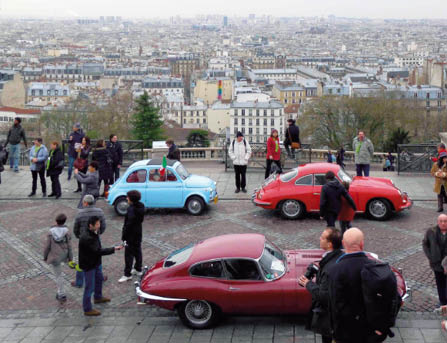
Stopping to enjoy the view from Montmartre. (Courtesy Vincennes en anciennes)
The success of the winter event has prompted the organisers to add a similar event in the summer. The principle is the same, but with the frequent bonus of excellent weather: there are plenty of convertibles joining the parade and participants often dress in period attire. The trip finishes with a huge open-air picnic in the grounds of the observatory at Meudon.

1917 Ford Model T Torpédo at the place Vendôme. (Courtesy Vincennes en anciennes)
Practical Information
- Opening Information: January and late July/August every year
- Address: Starts from the esplanade in front of the Château de Vincennes
- Metro Line: Line 1, Château de Vincennes
- GPS Coordinates: 48.840835 N, 2.435611 E
- Website: www.vincennesenanciennes.com
- Email: organisation@vincennesenanciennes.com


As well as organising the Traversées de Paris twice a year, the club Vincennes en anciennes, the largest multi-marque club in the Ile-de-France, runs an informal get-together – or ‘rencard’ in French – once a month, in front of the Château de Vincennes. The meeting is open to all enthusiasts, and pride of place is given to a different marque each month. The gathering at Vincennes is the best-attended of those in the Paris area and is popular even during the quieter winter months. It’s a great place to catch up with fellow enthusiasts over a coffee, and sometimes discover some rare models. And if your family or friends aren’t interested in cars, they can always visit the château!
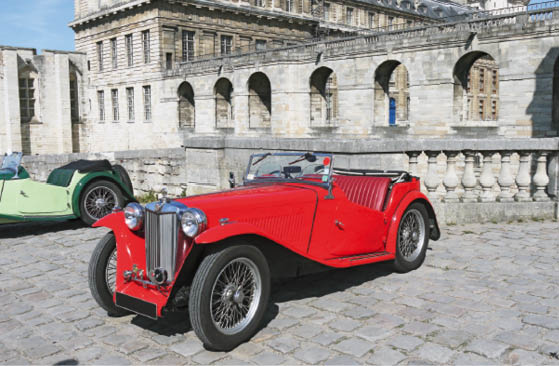
MG TF in front of the château.
Informal meetings like this are a key part of the classic car scene in France. In the Paris area there are also well-attended meetings run by Gazoline magazine near Versailles, and by local clubs in front of the châteaux at Chantilly (which also has a major equestrian museum), Rambouillet and Thoiry (where there is a zoo as well) – see a pattern developing here? The weekly newspaper La Vie de l’Auto gives a comprehensive listing of all upcoming meetings across the country.

MG – the marque of honour.
Practical Information
- Opening Information: The first Sunday morning of each month (check online for latest details)
- Address: The esplanade in front of the Château de Vincennes
- Metro Line: Line 1, Château de Vincennes
- GPS Coordinates: 48.840835 N, 2.435611 E
- Website: www.vincennesenanciennes.com
- Email: organisation@vincennesenanciennes.com


Youngtimers Festival, Montlhéry
When the events team at Montlhéry organised its first meeting for recent classics, or ‘Youngtimers’ as the French say, in 2012, they expected 100 or so cars to show up – and were staggered when 700 owners registered. As a new generation of enthusiasts looks back to their youth, the cars of the ’70s, ’80s and ’90s have become increasingly popular, sometimes to the dismay of owners of older classics. This one-day event, sponsored by Youngtimers magazine and open to the public, is the best of the shows dedicated to these emerging classics.
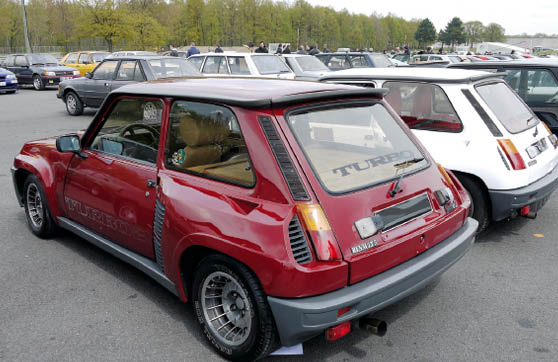
An immaculate Renault 5 Turbo 2
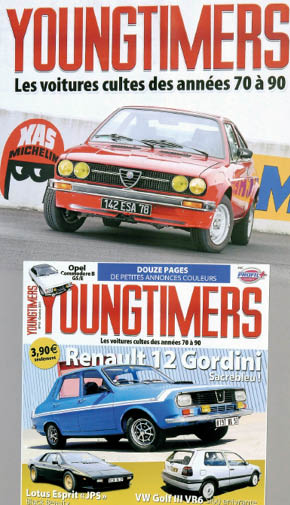
Youngtimers magazine, sponsor of the meeting.
Participants can opt to take their cars on the banked track – a popular choice for owners of pre-1982 performance models – or stay in the paddock, where several parts traders also take stands. Everyone gets the chance to join a parade lap at the end of the day. Citroën, Peugeot and Renault are the best represented makes, but there are plenty of BMWs, Mercedes and VWs, as well as rarer marques like Alpina and Venturi.
So successful has this show become that the organisers have added a second event in the autumn, held at Mortefontaine, north of Paris.

Looking out on the starting line: an eclectic mix of cars.
Practical Information
- Opening Information: April every year
- Address: Autodrome de Linas-Montlhéry, avenue Georges Boillot, 91310 Linas
- GPS Coordinates: 48.621999 N, 2.247294 E
- Website: events.utac.com
- Telephone Number: +33 (0)1 69 80 17 00
- Email: pae@utaceram.com


Of all the French auction houses selling historic cars, Artcurial is the largest and most prestigious. It holds auctions at Rétromobile, in Monaco, and at the Le Mans Classic, as well as at its own salerooms on the Champs-Élysées. So successful are some of its Parisian sales that it has even had to take over a nearby theatre to fit everyone in. Regardless of the venue, however, Artcurial’s auctions are a great spectacle to watch: Hervé Poulain, a former driver at Le Mans and originator of the BMW Art Cars, and Matthieu Lamoure really know how to work an audience!
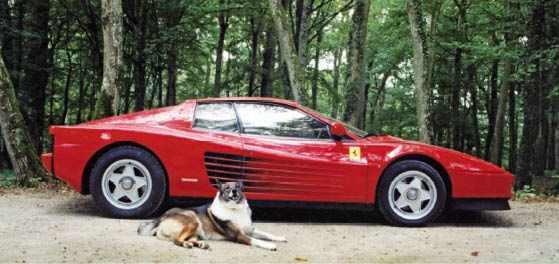
1987 Ferrari Testarossa which belonged to the film star Alain Delon – Shalva the dog not included! (Courtesy Artcurial Motorcars)

1962 Ferrari 250 GT Cabriolet, which sold for €827,000. (Courtesy Artcurial Motorcars)
The cars sold by Artcurial include many of the rarest and most valuable models traded in France: racing cars with a sporting pedigree, top flight restorations from workshops such as Lecoq, and cars from private collections built up over decades or owned by famous film stars, sometimes reaching over a million euros. But each sale usually features some more accessible cars, often in excellent condition, as well as a large selection of automobilia, including period drawings and mascots. Admission to the pre-sale viewing and auction itself is by catalogue; these are quite expensive, but a fine souvenir to keep.

Viewing the cars before a sale on the Champs-Élysées.
Practical Information
- Opening Information: Regular sales throughout the year (see website for details)
- Address: 7, rond-point des Champs-Élysées, 75008 Paris
- Metro Line: Lines 1 & 9, Franklin D Roosevelt
- Bus Services: Lines 28, 42, 73, 80, 83 & 93
- GPS Coordinates: 48.868708 N, 2.309271 E
- Website: www.artcurial.com
- Telephone Number: +33 (0)1 42 99 20 20
- Email: ihummel@artcurial.com


Renault has been part of the Champs-Élysées for more than a century and opened its first showroom here in 1910. By then, Paris’ most famous avenue was already home to France’s annual Salon Automobile (held in the Grand Palais) and the starting point for some of the country’s first unofficial motor races. At the outbreak of the First World War no fewer than 17 car manufacturers had showrooms here.
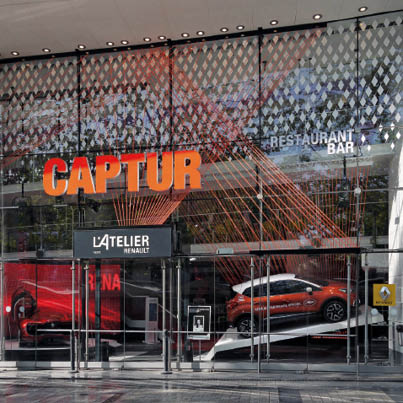
The façade of L’Atelier Renault, at the time of the launch of the Captur SUV.
In 1962 Renault transformed its site into Le Pub Renault, combining a display of cars with a bar and restaurant. With the creation of L’Atelier Renault in 2000 – modernised again in 2011 – Renault brought the concept right up-to-date. 2.5 million people now visit it every year.
Regularly changing displays feature Renault’s sporting achievements or their investments in electric power, whilst Renault Classic often shows cars from the company’s historic collections. Meanwhile, a retail section sells a good range of scale models, clothing and other goodies for the Renault and Alpine brands. Computer terminals and a range of books provide information on the company’s current range and history. Upstairs, the restaurant and bar is an often crowded meeting place, popular with cinemagoers as well as car lovers.
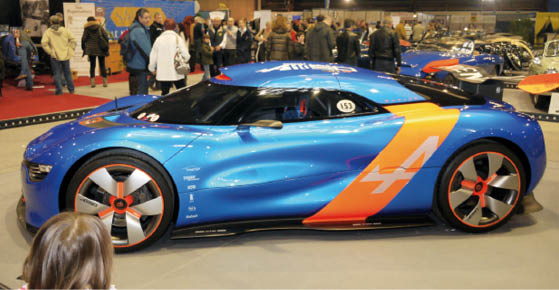
Alpine A110-50 prototype, seen here at the Avignon Motor Festival.
Practical Information
- Opening Information: Open every day, including evenings
- Address: 53, avenue des Champs-Élysées, 75008 Paris
- Metro Line: Lines 1 & 9, Franklin D Roosevelt
- Bus Services: Lines 32, 42, 73 & 80
- GPS Coordinates: 48.870344 N, 2.305486 E
- Website: atelier.renault.com
- Telephone Number: +33 (0)811 88 28 11
- Email: Contact form on website
